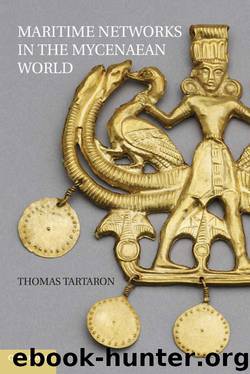Maritime Networks in the Mycenaean World by Thomas F. Tartaron & Thomas F. Tartaron

Author:Thomas F. Tartaron & Thomas F. Tartaron [Tartaron]
Language: eng
Format: epub
Publisher: Cambridge University Press
Published: 2013-08-29T16:00:00+00:00
(1) Investigation of known historical harbors; many have earlier histories as natural anchorages of the Bronze Age or Early Iron Age (e.g., Sidon, Tyre, Liman Tepe).
(2) Examination of modern natural anchorages to test, through geoarchaeological means, whether they existed as suitable anchorages in the Bronze Age.
(3) Focus on deltas and river mouths. Because these were favored as natural harbors in the Bronze Age, programs of geological coring may recover evidence of buried deltaic and estuarine systems of that age.
(4) Collection of information from local inhabitants, who often know of coastal and underwater archaeological sites. In addition, oral histories and archival data giving evidence of human activities in historical and modern times can provide analogies and insights into emic perceptions of maritime cultural landscapes (see Chapter 7).
(5) Intensive geomorphological and archaeological surface survey along the entire littoral zone of the study area to assess evidence for coastal landforms and to recover traces, however abundant or sparse, of human activity (with selective excavation, where possible, occurring at a later phase).
(6) Systematic search based on models of coastal exploitation. The Coasts and Harbors Survey, a subproject of EKAS, developed a GIS-driven probabilistic model for prehistoric harbor locations based on environmental and cultural variables (Rothaus et al. 2003; Tartaron et al. 2003). Ground-truthing the model resulted in the discovery of two major Bronze Age anchorages at Vayia and Kalamianos on the Corinthia's Saronic coast, and subsequent geoarchaeological investigation and archaeological prospection over the years has generally validated the principles and results of the model. In a different way, geoarchaeological analysis of the coast of Elis led to predictive statements about the locations of buried Bronze Age sites and coastal landforms (Kraft et al. 2005). In both cases, a Bronze Age coastline has been partially reconstructed from a modern littoral virtually devoid of recognizable anchorages, a first step to reconstituting humanized coastal worlds.
Download
This site does not store any files on its server. We only index and link to content provided by other sites. Please contact the content providers to delete copyright contents if any and email us, we'll remove relevant links or contents immediately.
| Anthropology | Archaeology |
| Philosophy | Politics & Government |
| Social Sciences | Sociology |
| Women's Studies |
Mysteries by Colin Wilson(3394)
People of the Earth: An Introduction to World Prehistory by Dr. Brian Fagan & Nadia Durrani(2701)
Ancient Worlds by Michael Scott(2622)
Foreign Devils on the Silk Road: The Search for the Lost Treasures of Central Asia by Peter Hopkirk(2432)
The Splendid and the Vile by Erik Larson(2354)
The Memory Code by Lynne Kelly(2352)
Come, Tell Me How You Live by Mallowan Agatha Christie(2212)
Lost Technologies of Ancient Egypt by Christopher Dunn(2193)
The Earth Chronicles Handbook by Zecharia Sitchin(2179)
The Plantagenets by Dan Jones(2038)
Last Chance to See by Douglas Adams(1933)
The Return of the Gods by Erich von Daniken(1895)
Wars of the Anunnaki by Chris H. Hardy(1681)
Keeper of Genesis by Graham Hancock(1607)
Before the Dawn by Nicholas Wade(1574)
The Cygnus Mystery by Andrew Collins(1520)
The Message of the Sphinx by Graham Hancock(1482)
Fragile Lives by Stephen Westaby(1421)
Hieroglyphs: A Very Short Introduction by Penelope Wilson(1312)
